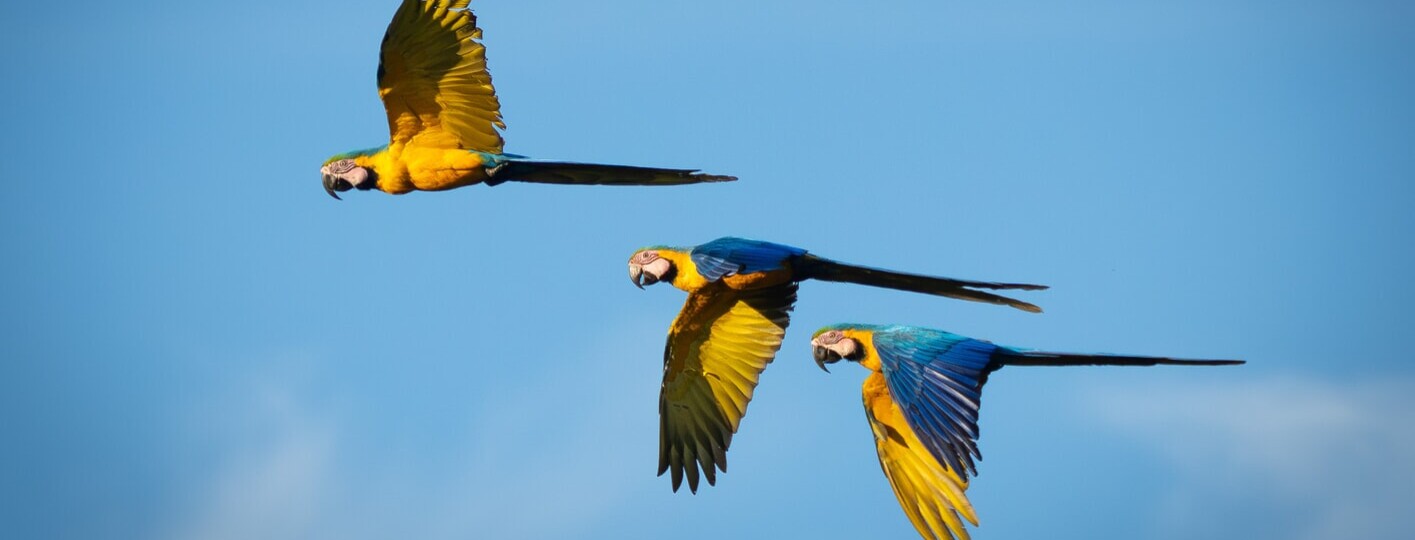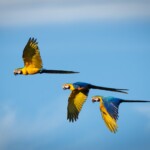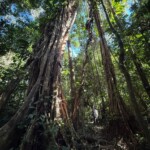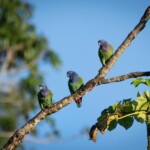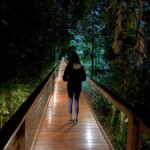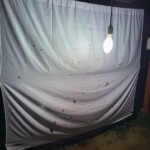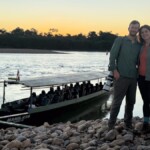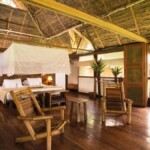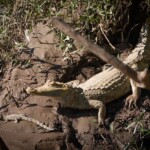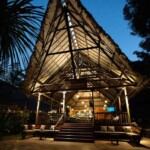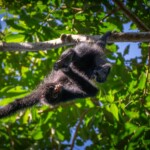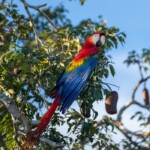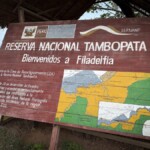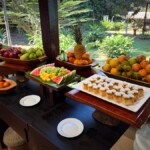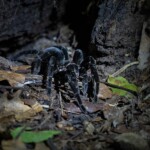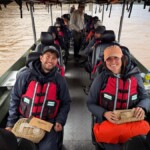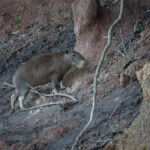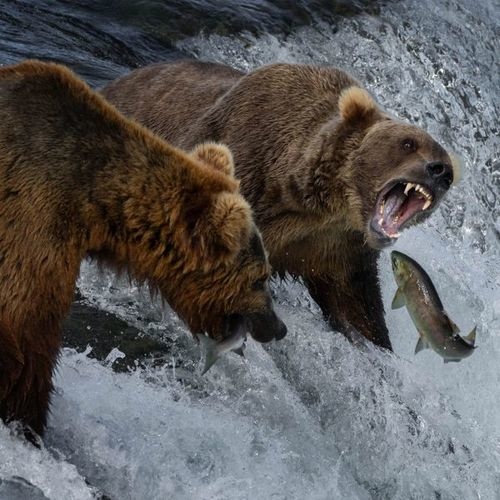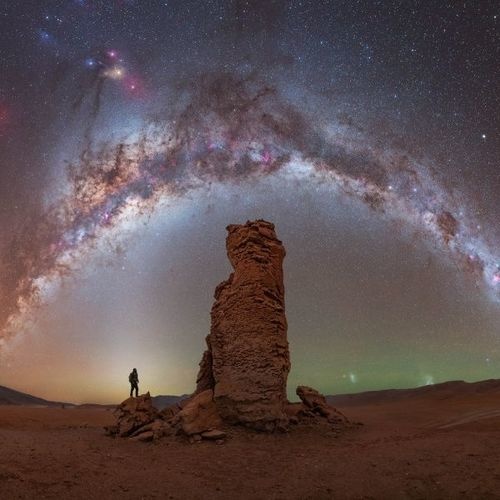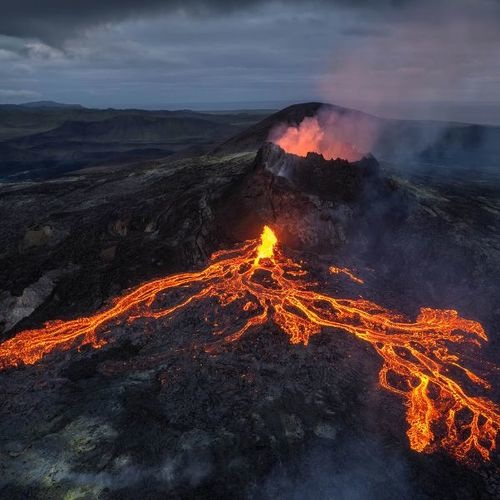The Tambopata Research Center (TRC) is, without a doubt, one of the most unforgettable places I’ve visited in the Amazon. I spent four nights at this all-inclusive ecolodge, tucked deep inside the remote Tambopata National Reserve of Peru, and from the moment I arrived, I was immersed in nature: monkeys swinging through the trees, macaws flying overhead, and the constant hum of the jungle all around me.
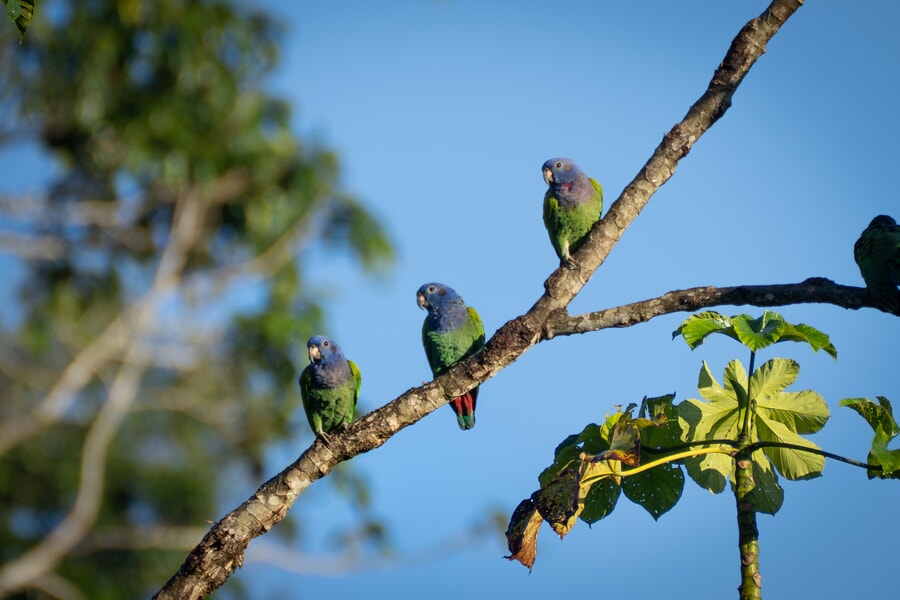
Tambopata Research Center Peru – Ecolodge & tours
But what really set this experience apart, though, was the chance to see conservation in action. I got to learn directly from the scientists and researchers based at the lodge, whose dedication to protecting this fragile ecosystem was both inspiring and eye-opening.
Tambopata Research Center, the best ecolodge in the Peruvian Amazon
The Tambopata Research Center is a hidden gem deep in the rainforest, but its conservation scientists have been working here since 1989. Operated by Rainforest Expeditions, a company known for its commitment to sustainable tourism, the TRC combines comfort, adventure, and scientific engagement in a way few jungle lodges can.
If you’re looking to experience the Amazon in a meaningful, responsible, and unforgettable way, this guide has everything you need to plan your visit. Here’s what I’ll cover:
- How to get to Tambopata Research Center
- Tambopata Ecolodge facilities and services
- Best activities at Tambopata Research Center
- Night lectures and other activities with TRC researchers
- Our experience visiting Tambopata Research Center
- What animals can you see at Tambopata National Reserve?
- What to bring & other tips for visiting Tambopata
- Other accommodation options in Tambopata
How to get to Tambopata Research Center
The TRC is in southern Peru’s Madre de Dios region. The town of Puerto Maldonado is the gateway to Tambopata, so you have to fly into Puerto Maldonado Airport (we flew from Cusco, and it was about a 1-hour flight).
Our guide met us at the airport and took us to the Rainforest Expeditions headquarters. There, they gave each of us a duffel bag to pack our essentials, as there’s a 33-lb (15 kg) weight limit per person. We had to leave our large suitcases safely stored at the headquarters during our stay. They also recommended keeping our flip flops handy, since other shoes aren’t permitted inside the ecolodge.
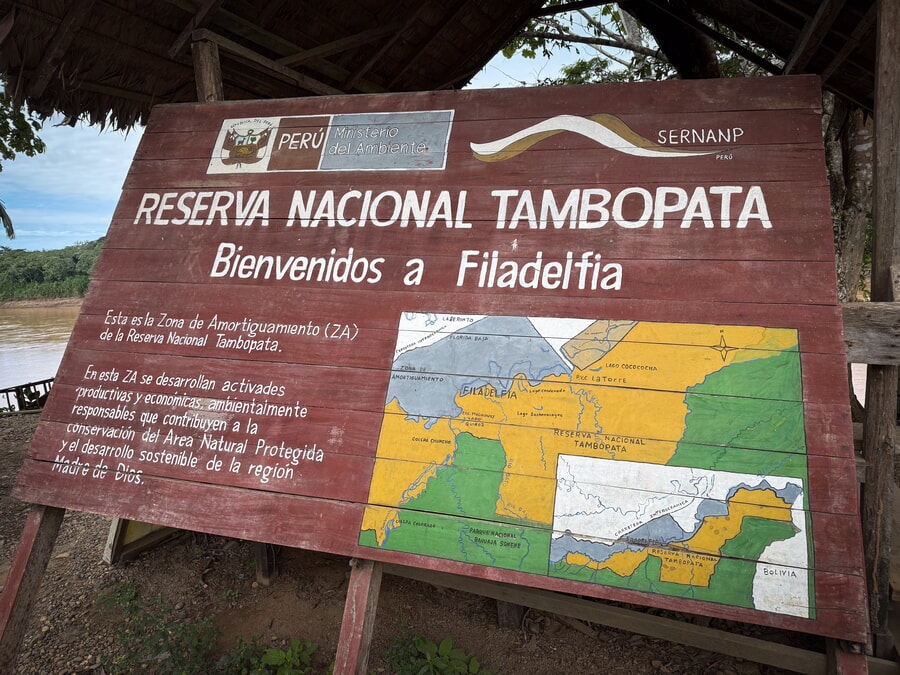
How to get to Tambopata Research Center
Once we finished packing, we traveled by bus for about 1.5 hours to the village of Filadelfia, followed by a scenic two-hour boat ride up the Tambopata River. Along the way, we enjoyed jungle views, a tasty lunch, and our first wildlife sightings.
It’s a bit of a journey, but completely worth it. The TRC is the only lodge located within the reserve itself, offering a level of remoteness and immersion you won’t find anywhere else.
Tambopata Ecolodge facilities and services
The lodge at Tambopata Research Center brings a bit of luxury to the dense jungle. The rooms are connected to the main building by elevated wooden walkways, so even getting from one area to another felt like part of the experience. You can walk around the property by yourself, but you need a guide to access the jungle trails and paths. Safety first!
We paid an extra fee to have a private guide, but you can also have the TRC assign you a tour guide once you arrive. Your guide will accompany you on all the activities and tours you do during your stay, and it’s included with your room rate!
The main building
The lodge’s main building has a common area for lounging and a restaurant/bar where we had all our meals. There’s also a reception area and a small souvenir shop.
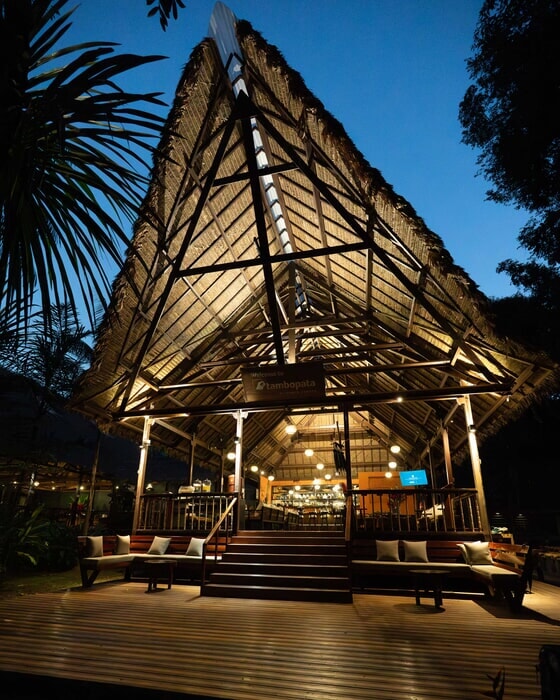
Main building at Tambopata Research Center
The rooms
There are four room types at TRC, each with a private indoor bathroom with a hot shower and eco-friendly toiletries.
The standard room is the smallest option and is next to the main building, while the comfort room is slightly larger. The suites offer more space and privacy, and we opted for one of those. There’s the standard suite and the deluxe suite, which comes with a private terrace with a hammock, seating area, and outdoor tub.

Suite at Tambopata Research Center
Hands down, the main draw of staying at this Tambopata Amazon lodge is that the rooms are open to the jungle on one side. The staff refers to this as “the big window,” and I never got tired of observing the wildlife and taking in the scenery from the comfort of our bed!
The food
The food at Tambopata Research Center is superb. We enjoyed the daily buffets for breakfast, lunch, and dinner, which included a mix of Peruvian and international dishes. Plus, coffee and tea were available throughout the day, and there were filtered water stations around the lodge for us to refill our water bottles.
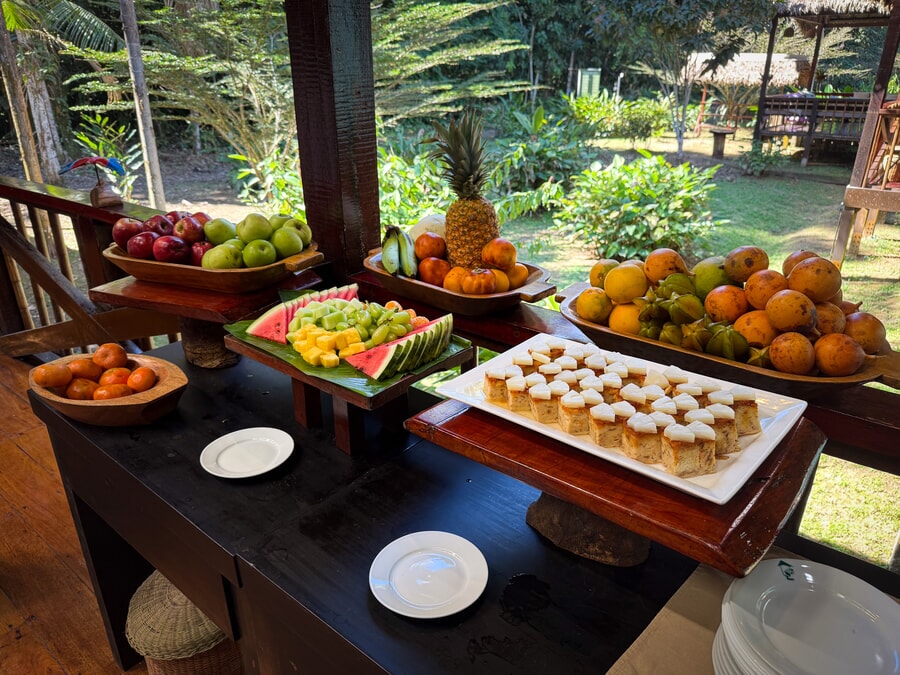
The food at Tambopata Research Center
Another thing that gave the lodge a homey vibe was the freshly baked goods that the chef prepared each morning. We always found a tray of tropical fruit and delicious snacks waiting for us after returning from our jungle activities.
Other amenities
The room rate includes transportation from Puerto Maldonado to Tambopata Research Center, your guide, meals, and activities. The only extra charges are for alcoholic beverages and massage services.
The lodge has a shoe-cleaning station and a rubber shoe rack so you don’t track mud into the lodge (they also provide rubber boots for guests, so you don’t have to take up precious room in your bag). There’s even Wi-Fi, and the signal was pretty strong for being deep in the jungle. Electricity was available for most of the day, making this one of the most sustainable – and luxurious – rainforest ecolodges we’ve ever seen.
Best activities at Tambopata Research Center
All of the activities at the TRC are included in your stay, so take advantage of them! As soon as we arrived at the lodge, our guide, Jonathan, explained all the possible options we have to choose from, so we were able to customize our own itinerary based on our interests.
See macaws and parrots at the clay lick
Perhaps the most mesmerizing experience at Peru’s Tambopata ecolodge was watching the birds at the Tambopata clay licks. Every morning, hundreds of macaws, parrots, and parakeets flock here to take in minerals and socialize.
The Chuncho Clay Lick is the most popular in the area. It attracts scarlet, red-and-green, and blue-and-yellow macaws. Located about an hour downstream by boat from the dock, it often draws visitors from several lodges, so it can get quite crowded. But that’s normal, as this is considered Tambopata’s star attraction.

See macaws and parrots at the clay lick
Still, I found it a bit underwhelming from a photography perspective. We were shooting with a 200–400 mm lens, but the birds were still too far away for any standout shots. Jonathan told us that the original Chuncho Clay Lick was slightly upstream, closer to the opposite riverbank, and offered better views. Unfortunately, the birds stopped frequenting that area because it lost its minerals, and groups don’t go there anymore.
Don’t get me wrong. The current Chuncho Clay Lick is still an incredible place to observe macaws in the wild. We saw plenty of them in action, just not close enough for any portfolio-worthy photos.
Surprisingly, our favorite spot was the Colorado Clay Lick, just a 10-minute boat ride from the lodge. While Jonathan told us that it isn’t as busy as it used to be, it delivered a colorful display of feathers and a constant chorus of chirps. Through our cameras, it felt like the birds were just a few feet away. And even if you don’t have your own gear, you can still enjoy a great view using your guide’s binoculars.
Look for monkeys and birds in the rainforest
Want to see monkeys in the wild? Say no more. One of the highlights of our trip was taking a Tambopata rainforest tour to see brown capuchins, dusky titis, red howlers, spider monkeys, and more. While sightings are not guaranteed, I’m confident you’ll see at least a couple of species during your stay. We spotted six different species out of the eight that inhabit Tambopata!
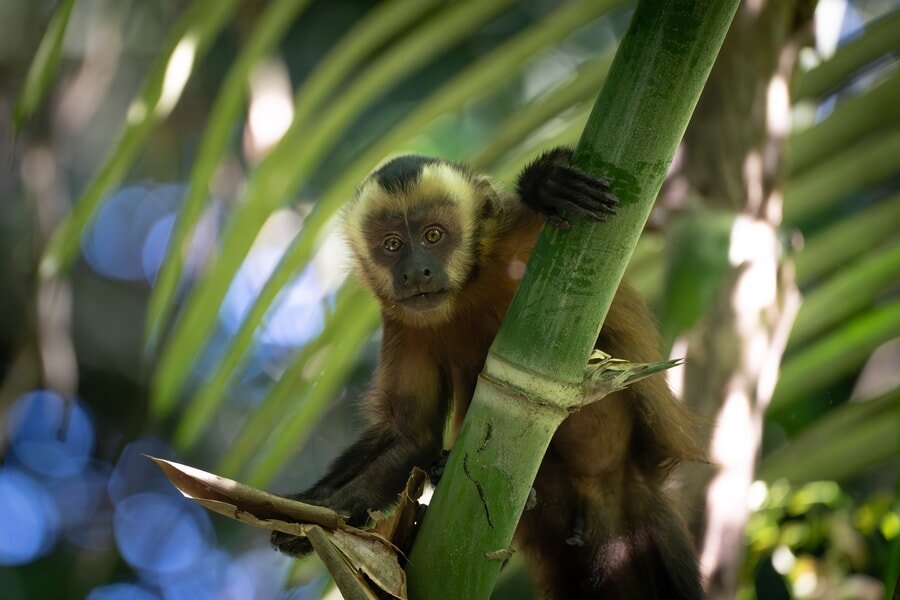
Look for monkeys and birds in the rainforest
Also, the reserve is home to over 500 species of birds, including colorful macaws, parrots, and toucans, which our guide helped us spot nesting in the trees.
Visit the canopy tower
About 45 minutes from the ecolodge sits a 98-foot (30-meter) canopy tower. Getting to the top takes some effort, but it’s well worth it. This was one of our favorite places to visit, and we asked our guide to take us there several times.

Visit the canopy tower
Climbing atop the tower gave us the chance to capture wonderful photos of different birds passing by. And we were even able to spot squirrel monkeys in the beautiful bamboo grove in the distance.
Explore the jungle on a night walk
One of the coolest experiences at TRC was taking a night jungle tour in Tambopata. I’m glad we had an experienced guide with us; Jonathan pointed out all the creepy crawlers before we had a chance to run into them accidentally. The jungle comes alive with nocturnal wildlife after dark, so we were able to see species that hide during the day, such as various frogs, snakes, insects…and a huge tarantula!
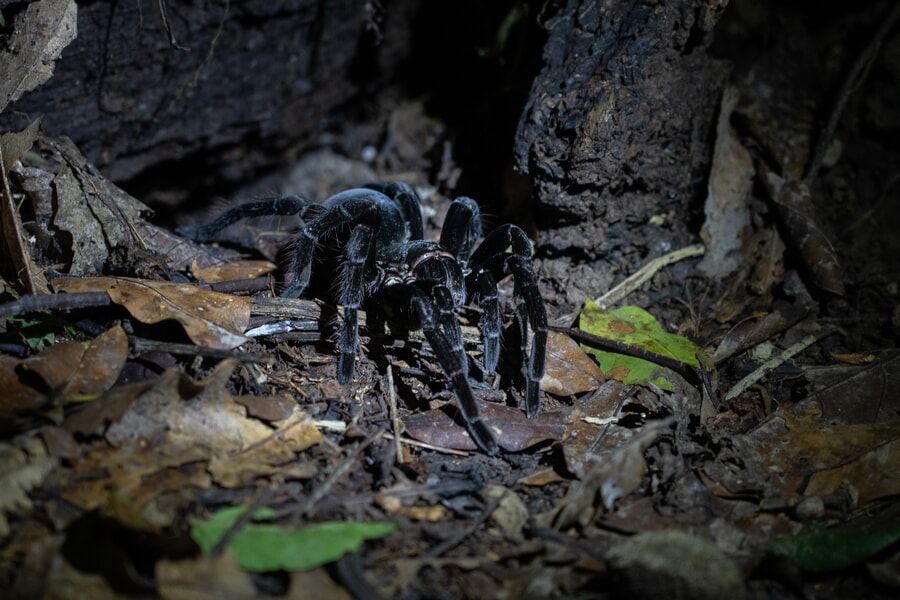
Explore the jungle on a night walk
Take a sunset boat ride
We did this activity twice during our stay, and for good reason. A sunset boat ride is one of the best ways to spot wildlife along the Tambopata River. We set off in the late afternoon, just as the jungle was starting to come alive with evening activity. The riverbanks are known for frequent animal sightings at this time, and many travelers who are lucky enough to see jaguars in Tambopata do so during this outing.
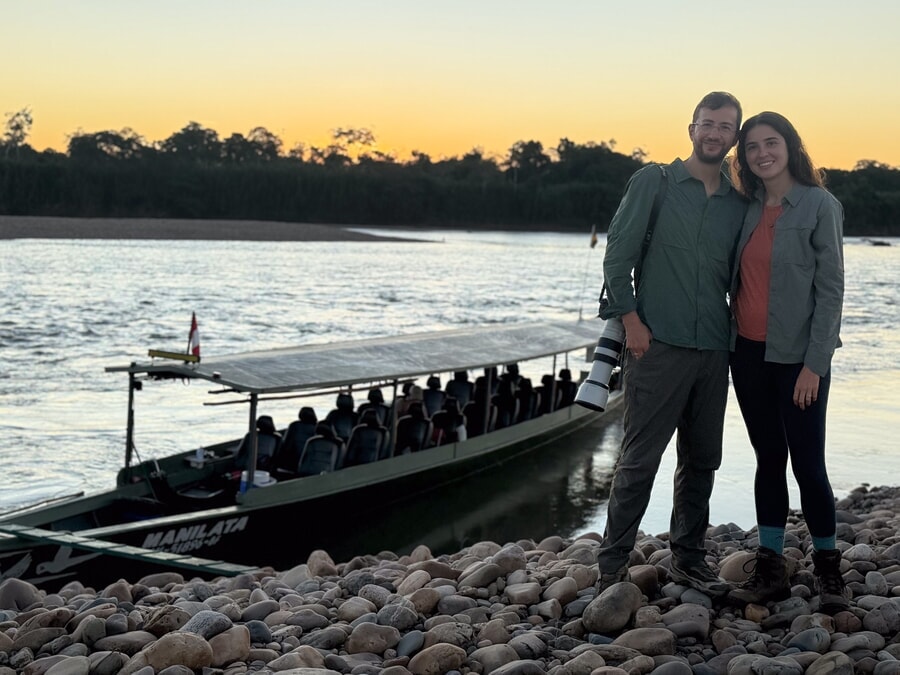
Take a sunset boat ride
We didn’t spot any jaguars ourselves, but we did see white caimans, turtles, and several monkeys moving through the trees. Even without a big cat sighting, the boat ride was a highlight and a great opportunity to observe wildlife from a different perspective.
Check out the island
On another occasion, we took the boat to explore the small island where the Colorado Clay Lick is located and saw waterfowl, turtles, caimans, and other animals. Our guide took us to the nearby pond, which transforms throughout the year. During the dry season, it’s covered in dense vegetation, while during the wet season, the water level rises, offering more wildlife-spotting opportunities.

Check out the island
Enjoy a massage in the heart of the jungle
For something extra special, you can book a massage at the Tambopata lodge. It’s not included in the stay, but if you’re feeling sore after long hikes through the jungle, it might be just what you need. We didn’t end up getting one. We were too busy exploring, but I have to admit, I was tempted!
Night lectures and other activities with TRC researchers
The Tambopata Research Center is dedicated to citizen science and conservation awareness. As a guest, I learned a lot, and I was impressed by the various research initiatives that were taking place deep in the Amazon jungle. Not only that, but there were opportunities to contribute to the projects, something I hadn’t seen in other ecolodges.
Night lectures
Every evening, at 6:30 pm, we listened to a research talk from one of the resident scientists. We heard about a different project each night, with the talks corresponding to the research taking place at the TRC. It was cool to hear about the projects and actually see those efforts in person. The lectures we attended were Discovering New Species, 8 Primates, Amazon Cam, and Macaw Project.
I loved them all and highly recommend sitting in on these talks. The scientists will explain the work of the researchers and activities you can do with them during your stay.
Discovering New Species (Moth collection)
Every night after dinner, guests at the lodge can join the Discovering New Species activity, led by one of the resident researchers. We joined one evening, and it turned out to be a surprisingly exciting experience.
That night, we accompanied the moth team to their light trap in the jungle: a bright lamp set up in front of a white sheet that attracts all sorts of moths and flying insects. Within minutes, the sheet was alive with fluttering wings, from tiny specks to moths as big as our hands.
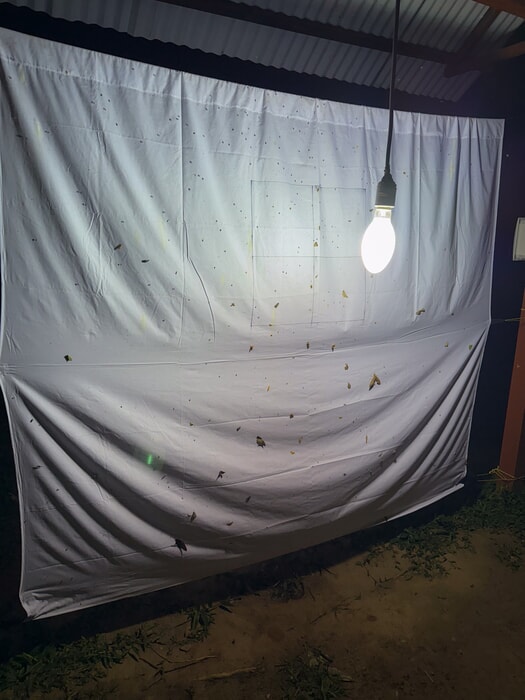
Discovering New Species (Moth collection)
At one point, the researcher pointed out a few specimens that looked unfamiliar to her and asked us to help collect them in small tubes. These would be sent to the Ontario University for DNA analysis to determine if they might be new scientific discoveries.
The next day, we received an email letting us know that our moths had been registered for further study. And here’s the exciting part: if any of them turn out to be a new species, the research team will contact us back so we’ll have the chance to name them!
We may not have discovered the next Lepidoptera celebrity yet, but just knowing we might have contributed to science (and could end up naming a species) made the night feel pretty extraordinary.
8 Primates (Monkey sound search)
At the Tambopata Research Center, the monkey research team is leading a fascinating initiative called the 8 Primates Project. Their goal is to document and study the vocalizations of the eight monkey species found in the region: brown capuchins, dusky titi monkeys, night monkeys, red howler monkeys, saddleback tamarins, spider monkeys, squirrel monkeys, and white-faced capuchins.
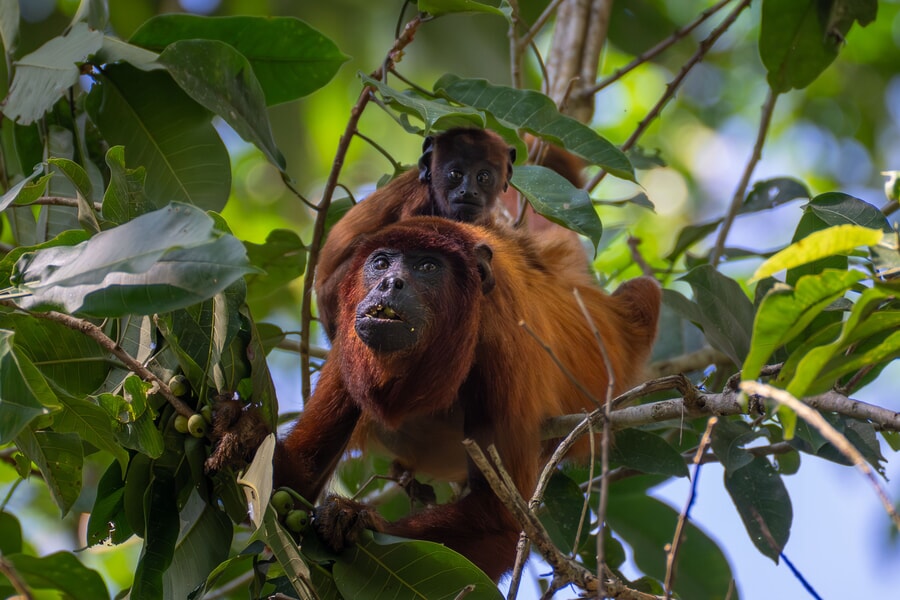
8 Primates (Monkey sound search)
Using specialized bioacoustics equipment, the researchers are building a catalog of monkey calls to better understand how these species communicate and interact. This method also helps monitor population trends more effectively than camera traps, since it doesn’t require the animals to be visible, just audible.
Guests can join the research team every day at 4:00 pm to help record new sounds in the jungle. You can even use the equipment yourself or record calls with your phone and share them with the scientists. These recordings are used to train artificial intelligence models that analyze thousands of hours of jungle soundscapes, allowing the team to track monkey populations and possibly uncover new patterns in their behavior.
Tambopata Macaw Project (Morning Nest Monitoring)
At the Tambopata Research Center, the macaw research team is conducting one of the longest-running parrot conservation programs in the world: the Tambopata Macaw Project. This initiative focuses on the behavior, reproduction, and conservation of the region’s large macaws, including scarlet, red-and-green, and blue-and-yellow macaws.
By monitoring both natural and artificial nests, researchers collect key data on chick development, parental behavior, and breeding success. These efforts help protect macaw populations and better understand their complex relationship with the ecosystem.
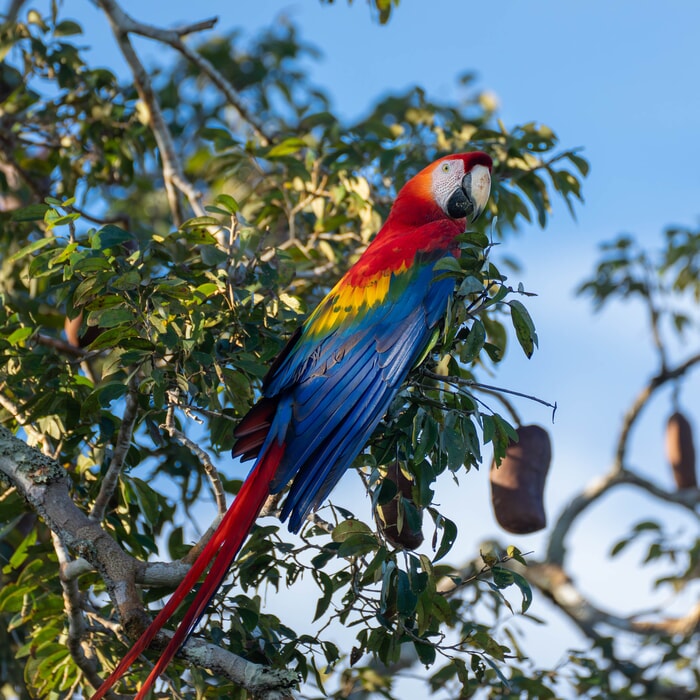
Tambopata Macaw Project (Morning Nest Monitoring)
Guests can check out the research team’s progress by monitoring the chicks through cameras placed inside and outside the nests. If you want to take your contribution further, you can sponsor a new artificial nest for $2,000, including installation. Sponsors can name the chicks that hatch there and even monitor their progress via a dedicated webcam. It’s a rare opportunity to witness macaw conservation in action and directly support a decades-long scientific effort to protect these iconic birds.
How you can contribute to science and research
I was blown away by the Tambopata Research Center’s dedication to ecological conservation and the way they encourage guests to get involved. During our stay, we learned that the research projects are part of Rainforest Expeditions’ Wired Amazon initiative.

How you can contribute to science and research
Once you return home, you can continue contributing to TRC’s mission by sharing your experience and raising awareness.
Our transformative experience visiting Tambopata Research Center
We booked 4 nights at the Tambopata Research Center. It was the perfect amount of time for us, as we wanted to spend as much time photographing wildlife as possible. Since we had our private guide, Jonathan, we were able to choose our own itinerary. Here’s how our adventure unfolded:
Day 1 – Arrival, Settling In & First Wildlife Encounters
We landed in Puerto Maldonado early in the morning after a short flight from Cusco and met our guide, Jonathan, who would be with us throughout our stay. After a quick stop at the Rainforest Expeditions office to repack into duffels and leave our large suitcases behind, we set off on the long but scenic journey to Tambopata Research Center: a 1.5-hour drive followed by a peaceful two-hour boat ride up the river, complete with a delicious jungle-style lunch and our first glimpses of wildlife.
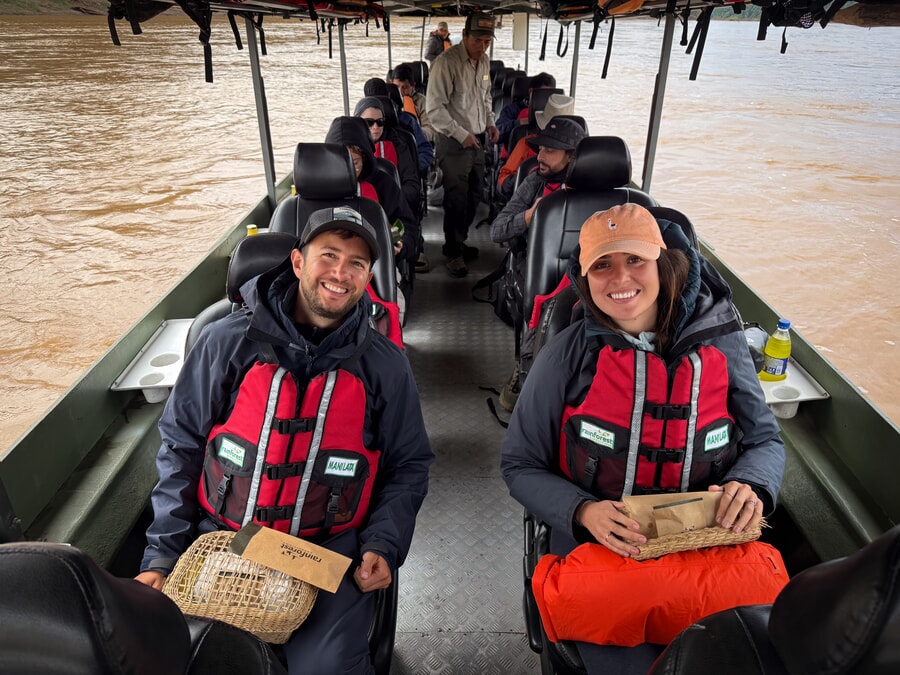
Day 1
We arrived at the ecolodge around 2:00 p.m. and walked through the jungle to our open-air suite complete with hammock, hot shower, and a full view of the rainforest. Most guests that arrived that day chose to relax for the afternoon, but we were too excited to sit still. Despite the late hour, we asked Jonathan to take us to the canopy tower for sunset. Most groups head to the tower at 3:00 p.m. and it was already 4:00. Still, we caught sight of nesting parrots and enjoyed the golden light filtering through the trees.
On the way back, we squeezed in a short night walk, spotting spiders, moths, and even a massive tarantula, an unexpected bonus on our first day. Before dinner, we attended our first night lecture, where researchers shared insights about camera trap studies and wildlife behavior around the lodge. It was a full day of travel and discovery, and we went to bed already enchanted by the magic of the jungle.
Day 2 – Macaw Mornings & Golden Hour in the Canopy
We started the day before sunrise with a 5:00 a.m. boat ride to the Chuncho Clay Lick. After an hour gliding along the misty Tambopata River, we arrived just in time to see dozens of macaws and parrots flock to the exposed clay wall. Although the birds stayed farther away than we’d hoped for close-up photography, watching them in their natural habitat was a mesmerizing experience. On the way back, we scanned the riverbanks for jaguars; they remained elusive.

Day 2
After a hearty lunch back at the lodge, we returned to the canopy tower earlier than the previous day and with much better light. The skies were clear, and the softer afternoon sun gave us the perfect setting to photograph scarlet and blue-and-yellow macaws flying overhead. On our walk back, a curious capuchin monkey made a surprise appearance and lingered long enough for us to get a good look.
That evening’s lecture focused on the Tambopata Macaw Project, an inspiring conservation effort to protect endangered macaws through the use of artificial nesting boxes. Learning how these strategies are already improving chick survival gave us a deeper appreciation for everything we had seen that day.
Day 3 – Jungle Hikes, Close Encounters & Citizen Science
We started the morning with a short boat ride to the Colorado Clay Lick; Jonathan had recommended it as a quieter alternative to Chuncho, with better conditions for photography. Only one other couple joined us, and while the birds kept their distance, we managed to capture a few good shots and spot several different parrot species.
Back at the lodge, around 7:30 a.m., we had a quick breakfast before embarking on the Rainforest Master Hike, an 8-mile loop that took us through nearly every trail in the area. Along the way, we passed massive ceiba trees, dense bamboo groves, swampy clearings, and scenic viewpoints. The highlight was spotting four different monkey species in a single morning: capuchin, howler, titi, and spider.

Day 3
We returned to the lodge around 1:00 p.m. for lunch, then set out again in the afternoon for a sunset boat ride. They said that this is the activity that gives you the highest chances of spotting jaguars, but they continued to evade us. Still, we enjoyed close sightings of squirrel monkeys and white caimans. Just before docking, we spotted a group of night monkeys near the lodge, bringing our monkey count to six of Tambopata’s eight species.
That night’s lecture focused on the discovery of new moth species, and after dinner, we were able to join one of the researchers at a light trap to help collect specimens. Some would be sent for DNA analysis, and if any turned out to be new to science, we’d get the chance to name them. A pretty unique way to end the day!
Day 4 – Tower Views, River Life & One Last Night in the Jungle
We kicked off the day with an early visit to the canopy tower; this was our favorite photography spot, and the morning light made it even better. Parrots flew close by, the forest was glowing, and we even had a good look at some squirrel monkeys moving through the treetops. Afterward, we went for a walk through the jungle and spotted two snakes, trumpeter birds, howler monkeys, an owl, and a caiman mom with her offspring.
Since a boat was available, we made a quick return to the Colorado Clay Lick. It was already late in the morning, so bird activity was low, but we enjoyed exploring the small island and nearby pond that changes with the seasons.

Day 4
After lunch at the lodge, we set out on one final boat ride along the Tambopata River. Jaguars continued to hide, but we saw plenty of white caimans and had a close encounter with a capybara at the mammal clay lick, just six feet away from us. The calm river and soft light made for a peaceful farewell outing.
That evening’s lecture was all about the eight monkey species of Tambopata and how researchers are using sound detection to study them. We had managed to see six species during our stay, so I felt pretty lucky. But next time, I hope to catch a glimpse of the elusive white-faced capuchin and tamarin.
After dinner, we joined Jonathan for a final night walk through the jungle. It didn’t disappoint; we spotted a deer, several tarantulas, snakes, frogs, toads, and a few too many spiders. It was the perfect end to our last full day in the Amazon.
Day 5 – Departure
On our last day, we had breakfast at 7:00 a.m. and took the boat back to the port half an hour later. Since we were traveling downstream this time, it was a shorter ride, and we got to the Filadelfia dock at around 9:00 a.m. I was hoping we’d be lucky enough to spot a jaguar, but alas, it wasn’t meant to be.

Day 5
An hour and a half later, we were back in Puerto Maldonado, reunited with our luggage and preparing for the trip home.
If we had an extra day or two, I would’ve loved to spend some more time here and take this day trip to visit Lake Sandoval (by the Madre de Dios River) to try our chances at spotting giant river otters. But that just gives us the perfect reason to return, and maybe next time, the jaguars will be waiting.
What animals can you see at Tambopata National Reserve?
We were excited to stay at the TRC because it’s located deep in the jungle. We knew this would be a great place to capture wildlife photos and get a closer look at different species. The Tambopata National Reserve is one of the most biodiverse regions in South America, so you never know what you’ll see. Some of the species you may encounter include:
- Agoutis
- Caimans (Black and white caimans)
- Capybaras
- Frogs and toads (Cane toad, poison dart frogs, Tambopata poison frog)
- Macaws (Blue-and-yellow macaws, red-and-green macaws, scarlet macaws)
- Monkeys (Brown capuchins, howler monkeys, titi monkey, night monkeys, saddleback tamarins, spider monkeys, squirrel monkeys, and white-face capuchins)
- Moths & butterflies (Blue morpho butterflies, glass butterflies, tiger moths and many more)
- Jaguars (if you’re really lucky)
- Other birds (Aracari, egrets, harpy eagles, herons, hummingbirds, jacamars, kingbirds, parakeets, piping guans, tanagers, toucans, trogons, owls)
- Other insects and spiders (Brazilian wandering spider, bullet ants, tarantulas)
- Parrots (Blue-headed parrots, orange-cheeked parrots, white-bellied parrots, Amazonian parrots)
- Peccaries
- Snakes
- Tapirs
- Turtles
Of course, we didn’t see every species on this list. But one of the great things about staying at the Tambopata Research Center is that you can tell your guide what you’re most interested in spotting, and they’ll take you to the parts of the jungle where you’ll have the best chances. We saw a wide variety of animals, birds, and insects, although I have to admit, I was still hoping to catch a glimpse of a jaguar. We met another guest at the resort who saw a jaguar 2 days in a row just before we arrived, and she showed us pictures. So, it’s possible, but not guaranteed, as we learned the hard way.

What animals can you see at Tambopata National Reserve?
In fact, this was actually our second time exploring the Peruvian Amazon. The first time, we visited Manu National Park, which is often said to offer even better chances of spotting jaguars. But no luck there either! Maybe third time’s the charm?
What to bring & other tips for visiting Tambopata
The Tambopata Research Center and ecolodge is deep in the Amazon rainforest, so you must pack accordingly. These are the essentials we brought for our visit:
- Binoculars
- Camera and telephoto lens
- Dark-colored clothing
- Daypack
- Flashlight
- Insect repellent
- Raincoat or poncho
- Sandals or flip-flops for walking around the lodge
- Sneakers
- Sun hat or cap
- Sunglasses
- Sunscreen
- Thin cotton pants/shirts
- Travel insurance for Peru
We also made sure we were up-to-date with our vaccinations. Travelers visiting the Amazon should have the yellow fever vaccination, and it’s also a good idea to be vaccinated against Hepatitis A, Hepatitis B, and typhoid fever.
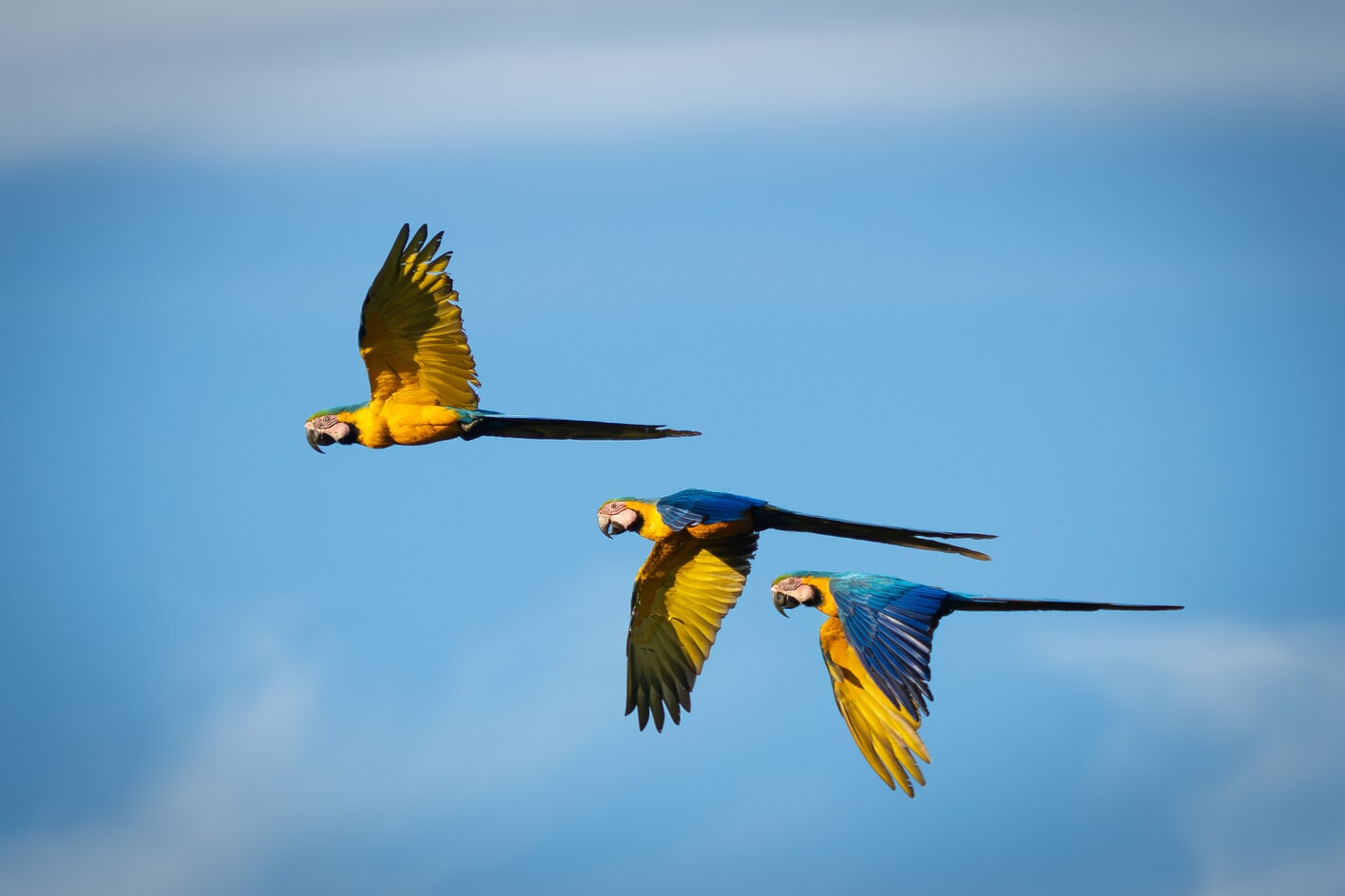
What to bring & other tips for visiting Tambopata
Another thing to keep in mind is the weather. We visited in July, which is the middle of the dry season (May-October), so it was hot and muggy. If you visit during the wet season (November-April), it’ll be a bit cooler, but the trails will be muddier. The lodge provides rubber boots for guests, so you don’t have to bring any.
Finally, remember that there is a luggage weight limit, so pack light!
Other accommodation options in Tambopata
In addition to the Tambopata Research Center, Rainforest Expeditions operates two other ecolodges, although the TRC is the only one within the national reserve. The Posada Amazonas is the closest to Puerto Maldonado, while the Refugio Amazonas is in between.
We were drawn to the TRC because it’s the only hotel inside Tambopata National Reserve. However, there are lodging options right outside the reserve, such as the Tambopata Ecolodge between the Posada Amazonas and Refugio Amazonas. About 4.5 miles downstream from the Refugio Amazonas, there’s the Wasai Tambopata Lodge, a more family-friendly alternative.
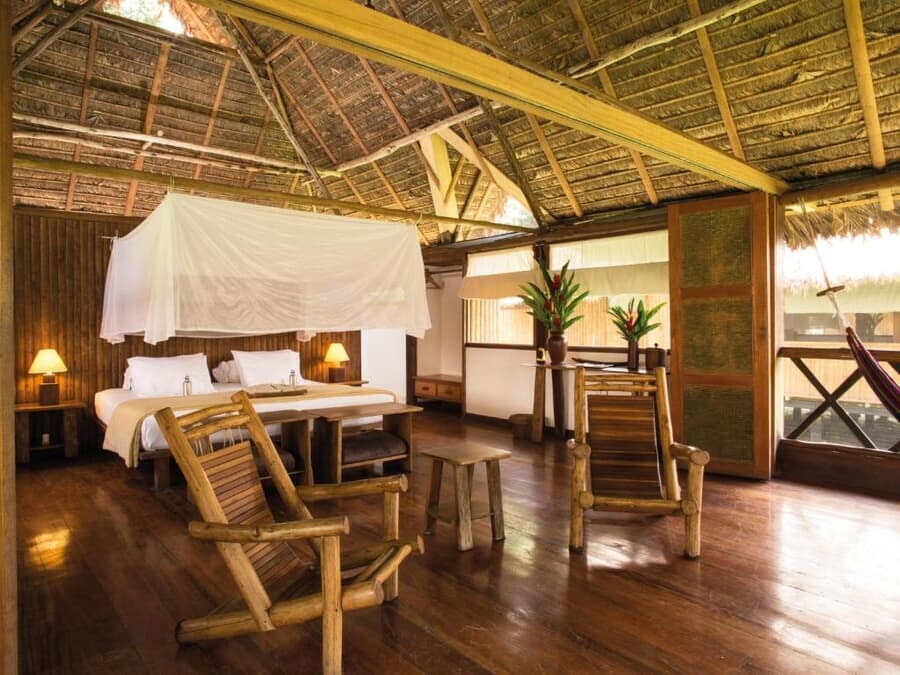
Other accommodation options in Tambopata
The Tambopata River flows into the Madre de Dios River, where there are many other accommodation options. Staying here is a better alternative if you definitely want to visit Sandoval Lake. The Corto Maltes Amazonia Lodge is very popular and, like the TRC, offers jungle tours. Another wonderful option is the Inkaterra Reserva Amazonica, which offers an all-inclusive rate and tours. A friend of mine stayed there and loved it!
We’d come back to the Tambopata Research Center in a heartbeat, so I highly recommend it. There’s no better way to explore Peru’s Tambopata National Reserve! Let me know if you’ve been here or if you’re planning to. You won’t regret it!
